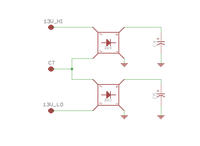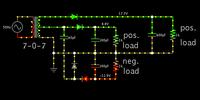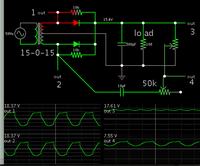JonathanRalph
Newbie level 6

Hello everyone. So basically I was going to construct a circuit which is composed of an opamp precision half wave rectifier (bottom part of schematic) and its power supply (upper part of schematic). The left side of the schematic is a center tapped, 220Vac to 15Vac (both in RMS) 1A transformer. I wanted to integrate both the opamp rectifier and its power supply into one whole circuit and connect them to the ct transformer. The input side of the supply circuit is 15Vac and the output is 12Vdc. The input of the opamp rectifier is 7Vac (I used a 10k potentiometer to decrease the voltage to avoid clipping). I want to get both the 15Vac and the 7Vac from the transformer.
My problem here is that I don't know how to connect all three part of the circuit together WITH proper grounding/current return path. Is putting all three together possible or should I use two separate transformers for the power supply and the opamp circuit for better results?
If anyone has a sample schematic of a circuit with a built in power supply then sharing it to me would be greatly appreciated. Thanks!
- - - Updated - - -
Oops. Neglect the circuit at the right.
My problem here is that I don't know how to connect all three part of the circuit together WITH proper grounding/current return path. Is putting all three together possible or should I use two separate transformers for the power supply and the opamp circuit for better results?
If anyone has a sample schematic of a circuit with a built in power supply then sharing it to me would be greatly appreciated. Thanks!
- - - Updated - - -
Oops. Neglect the circuit at the right.
Attachments
Last edited by a moderator:







